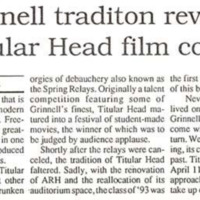Browse Items (10 total)
Sort by:
-
35th Anniversary of Titular Head Film Festival
2024 marks the 35th Anniversary of TItular Head Film Festival! -
30 years of the Titular Head Film Festival
The Titular Head Film Festival has continued as a Grinnell College tradition for 30 years. In 2020, Titular Head was held virtually for the first time via livestreaming amidst the COVID-19 pandemic. -
First Titular Head Film Festival Held
1989 marked the first year that Titular Head was held independently from the Grinnell Relays as the student film competition. In 1992, Titular Head was revived after a 2-year hiatus. -
Titular Head annually held at the Grinnell Relays Weekend
Through the 1970s and 1980s, Titular Head was annually held on an evening of the Grinnell Relays Weekend. -
1st Titular Head Contest Held at the Grinnell Relays Weekend
"Titular Head, now known as a student film festival and competition, marked its beginning as a different type of competition – “a cross between the Miss American Pageant and a ... Homecoming Queen”.
The contest took place on an evening before the Relays (another Grinnell tradition).
“[The Titular Head of the Relays will be] judged on the absurdity of the dress, originality of talent, and imagination in answering questions asked by the judged”. " -
View of Sommerspiret, the Cliffs of Møn, 1846
"In the first half of the nineteenth century, Denmark experienced an artistic “Golden Age”. Following the Napoleonic Wars, the small, peninsular kingdom suffered English naval aggression, the dissolution of its partnership with Norway, and increasing hostility with Germany. As modern Denmark emerged as a constitutional monarchy, artists sought a unifying and stabilizing identity for the nation. Inspired by German romantic nationalism, best represented by the mesmerizing meditations on landscape of Caspar David Friedrich, Danish artists produced meticulous images in crystalline light of their native countryside. In the colors and contours of the Danish landscape, they sought to define a distinctly national spirit.
Georg Emil Libert was trained at the Royal Academy of Fine Arts in Copenhagen, where Friedrich himself had studied. Like Friedrich, Libert specialized in landscape painting. Here, he pictures the white chalk cliffs of the island of Møn in the Baltic Sea, not far from the island of Rügen where Friedrich painted several celebrated images of chalk cliffs. Much of Demark exists on a plateau of white chalk. In places, the bleach-white earth erupts into the sun, washed by the sea. The tourist destination gained additional appeal from the Sommerspiret, or summer spire, a towering chalk formation gleaming against the bright blue Danish sky. Several Danish Golden Age painters, including Christoffer Wilhelm Eckersberg and Louis Gurlitt, painted the Sommerspiret. (Alas, in 1988 it naturally eroded into the sea.) The high degree of finish, clear, harmonious tones, and the inclusion of small figures beholding the marvelous scene are classic characteristics of this moment in the history of landscape painting."
(from the National Gallery of Art website) -
In Memory of Hannibal Kershaw
In this block the artists decided to honor Hannibal Kershaw and recognize the legacy he left on Grinnell during his time here as a student. Hannibal Kershaw was the first black student to graduate from Grinnell College in the early 19th century. The Iowa College Newsletter called Kershaw “an earnest, conscientious student, a fluent society speaker, and a man whom all respected for his high moral and religious character.” After graduating from Grinnell, he became a member of the South Carolina legislature and was also a teacher and a minister. Although Kershaw passed away only 4 years after leaving Grinnell, his memory is honored in the East Campus hall named for him, and now also in this piece of art. In this block, the artists have included a photograph of Kershaw along with the commemorative sign on Kershaw Hall, as well as keys and screws to symbolize not only the dorm, but also Kershaw’s commitment to building respectful race relations at the college and the symbolic doors he opened as the first black graduate of Grinnell. The artists also included a bird in flight, meant to remind viewers that while loved ones may be gone, their legacy will be remembered forever. Lastly, a piece of twine placed between these images reminds us of how connected the struggles of people of color are all over the world. Although Kershaw never set foot in Haiti, he certainly knew the pain and legacy of slavery and colonization, and felt the burn of racism even in Grinnell.





